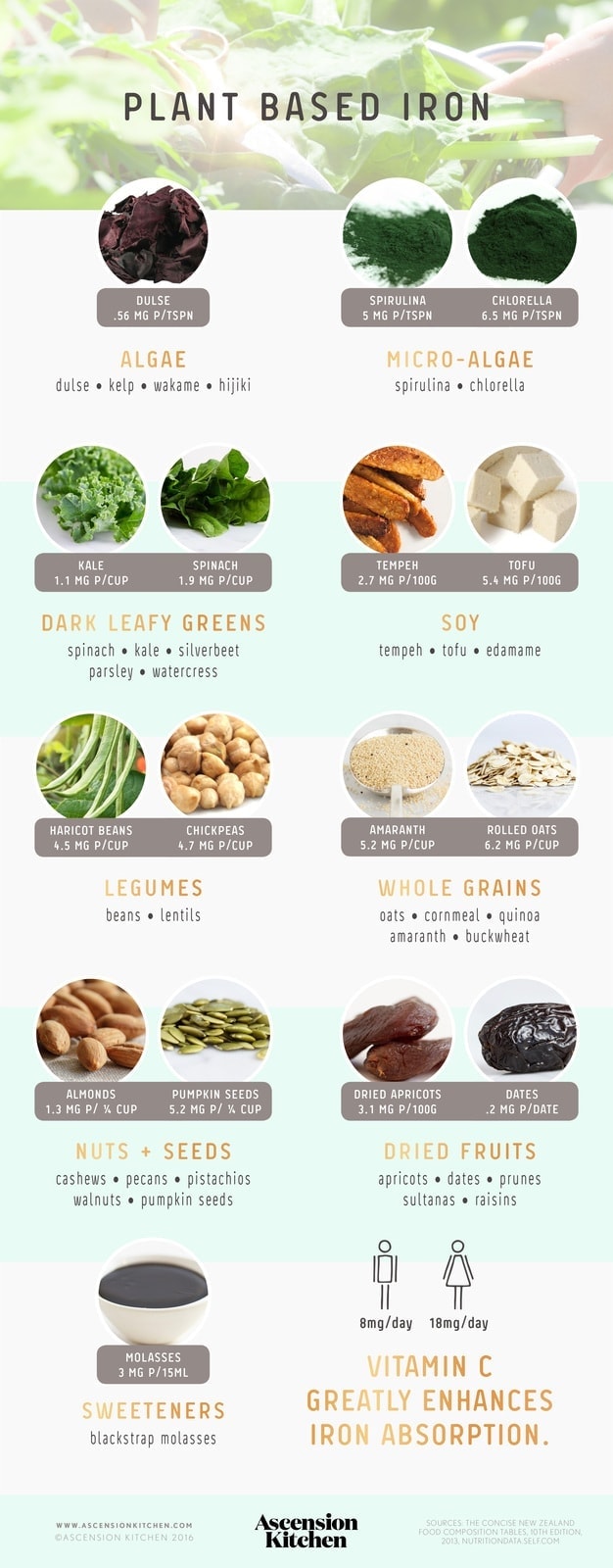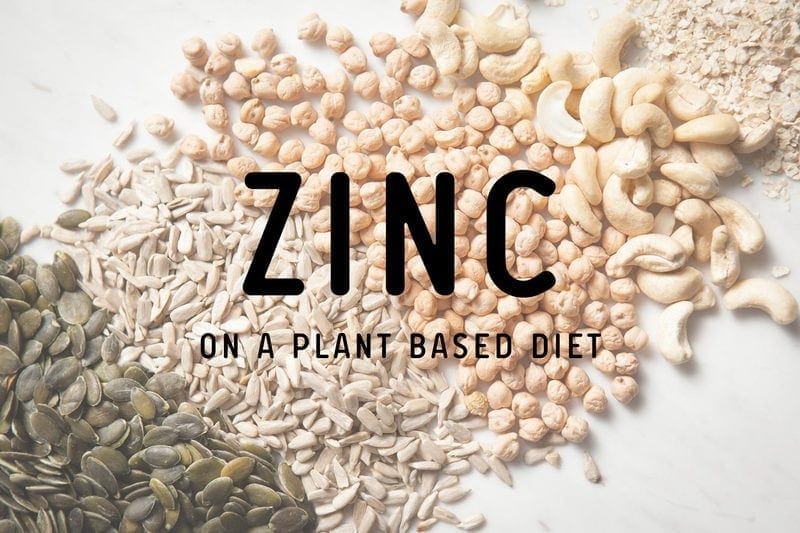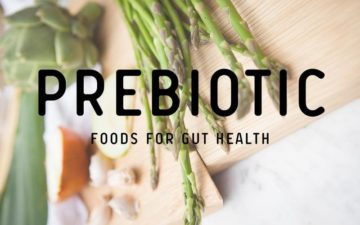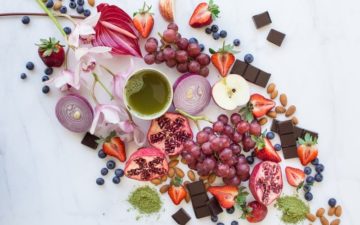
This is the second of a series of posts I am sharing on plant based nutrition. I have personally enjoyed a plant based diet for close to ten years. Some of which have been as a vegetarian, and some as vegan. I have experienced numerous deficiencies during my journey, partly due to malabsorption, though I believe a lack of education was at the heart of it all. Yes, you can be healthy and well on a conscious and compassionate diet – but it takes careful planning and awareness of what your own unique body needs.
[bctt tweet="Iron on a Plant Based Diet – what you need to know. Learn more here."]
What you need to know
Iron is an essential trace mineral, and is needed to make haemoglobin and myoglobin. There are two types of iron in food. Haem iron is derived from animal sources (meat, fish, poultry), while non-haem is derived from plant and dairy sources. Non-haem iron is not as readily absorbed as haem iron. 25% of the world’s population are iron deficient.
Plant-based diets can provide enough iron to prevent deficiency. In fact, they may even provide more dietary iron than an omnivore diet. Although studies reveal vegetarians typically have lower iron stores, there does not seem to be any difference in occurrence of iron-deficiency anaemia.
There are numerous factors that affect how well non-haem iron is absorbed, the phytate content of grains, legumes, nuts and seeds is of most concern. However, these compounds can be reduced or neutralised via food processing or preparation methods. A healthy microbiome will also contribute to the liberation of iron entrapped in phytic acid. Vitamin C, other acids (from citrus) and natural fruit sugars all enhance absorption. Even cooking in cast iron pans has shown to be beneficial.
Iron RDI:
8 mg/day for adult men
18 mg/day for adult women (19-30 yrs)
8 mg/day for adult women (51+ yrs)
The upper level of intake (the highest level of a daily nutrient intake that is likely to pose no risk of adverse health effects for almost all individuals in the general population) for iron in adults is 45 mg/day.
For the full list of recommendations by life stage and gender, including pregnancy and lactation, visit the Nutrient Reference Values for Australia and New Zealand here.
[1].
Introduction
Iron is vital to human health. It is classed as a trace mineral as the body only needs very small amounts. There are on average just 2-4 g of iron in the human body. Too little iron can be just as problematic as too much [2].
About 70% of the body’s iron is found in the proteins haemoglobin and myoglobin. Haemoglobin is essential for transferring oxygen in the blood from the lungs to the tissues, while myoglobin accepts, stores, transports and releases oxygen in muscle cells [2].
There are many forms of iron, however the two that are biologically relevant are the ferrous (Fe2+) and ferric (Fe3+) forms [3].
Haem and non-haem iron
Food contains two types of iron: haem and non-haem. The haem form of iron comes from animal sources and has a good bioavailability. Non-haem iron is derived from plant and dairy sources [4]. Haem iron is well absorbed at about 25%, while non-haem iron is less well absorbed at about 17% [2]. The body aims to maintain iron homeostasis. It will increase absorption in a deficient state, and decrease absorption when stores become overloaded [2].
Plant based sources of iron include:
- Dark leafy greens (spinach)
- Legumes
- Whole grains (such as quinoa, amaranth)
- Nuts and seeds (particularly cashews, pumpkins seeds, sesame and tahini)
- Soy (tofu)
- Dried fruits (such as figs, prunes, apricots and dates)
- Algae and micro-algae (spirulina)
- Molasses
- Iron-fortified breakfast cereals and breads
[4, 5].
What does iron do?
- Iron is most importantly needed to facilitate the transport of oxygen in the blood via a protein carrier called haemoglobin, in red blood cells
- It is also critical for the storage of oxygen in myoglobin within muscle cells, releasing it to meet metabolic demand
- Iron serves as a cofactor to enzymes in many metabolic reactions. It is needed to help make amino acids, collagen, hormones (such as thyroid hormone) and neurotransmitters (such as serotonin and dopamine)
- Iron is a component of enzymes that serve as protective antioxidants
- Iron has a key role in cellular energy production. Haeme-containing enzymes called cytochromes have an important role in the electron transport chain, shuttling hydrogen and electrons to oxygen, forming water and making ATP – the cell’s energy currency
- Non-haem iron-containing enzymes also feature in the citric acid cycle; a series of chemical reactions within cells that break down carbohydrates, fats and proteins to generate energy
- Iron is required for DNA replication and repair
- Iron is required for the proliferation of immune cells, it also has a pro-oxidation property which enables immune cells to engulf and destroy bacteria
[2, 3, 4]
Iron Deficiency
- 25% of the world’s population are iron deficient
- Vegetarians and vegans do not appear to have higher rates of anaemia than the rest of the population
- Vegetarians and vegans do appear to have lower stores of iron, though still in a healthy range
- The most deficient groups globally are children and young women
Iron deficiency is the most common nutrient deficiency worldwide [3]. It affects almost 25% of the global population, particularly, pre-school aged children and non-pregnant women [3].
Vegetarian and vegan needs
Research suggests that vegetarian and vegan diets contain just as much, or more iron than omnivore diets [6, 7, 8]. For example, the EPIC-Oxford study, one of the largest studies of vegetarians in the world, looked at iron intake in over 30,000 non meat-eaters. They found no significant difference in daily iron intake between meat-eaters, fish-eaters, vegetarians and vegans (in fact, vegans had slightly higher intakes) [9].
The American Dietetic Association state that although vegetarian adults have lower iron stores than non-vegetarians, their serum ferritin levels are usually within the normal range [10].
Vegetarians and vegans do not appear to have higher rates of anaemia than those seen in the general population [10].
Depletion of iron stores and iron-deficiency anaemia can occur in all age groups. Iron deficiency and iron-deficiency anaemia are not the same [2]. Iron-deficiency anaemia is the final stage/end result of depleted iron stores. It is a condition in which the number of red blood cells and the haemoglobin within them is low [11]. You can be iron deficient without being anaemic.
Some stages of life are more vulnerable to iron deficiency, for example women in their reproductive years lose blood during menses, during pregnancy iron requirements are greater, and infants and children need extra to support rapid growth [2]. Deficiency is most commonly caused in adults by loss of blood [11].
Causes of iron deficiency:
- Loss of blood (such as excessive menstrual bleeding, bleeding from a gastrointestinal ulcer, malignancy)
- Malabsorption of dietary iron (which could be due to a dietary inhibitors, or conditions such as Celiac’s disease)
- Inadequate dietary intake (particularly in those with increased needs – pregnant women, infants, children, adolescent girls)
- Some medications, such as protein pump inhibitors
- H. pylori infection
[4, 11].
Although an iron deficiency will eventually cause low haemoglobin, there are other nutrient deficiencies that can also affect haemoglobin concentrations. These include folate and vitamin B12 deficiencies [2].
Symptoms:
Iron-deficiency anaemia will develop when iron stores are exhausted. Signs and symptoms include:
- Pale skin
- Weakness
- Fatigue
- Impaired concentration
- Decreased resistance to infection
- Pica (a craving for non-foods such as ice, dirt or chalk)
- Pale coloured nail beds
- Spoon nails (thin and concave nails)
- Brittle nails
- Pale mucous membranes (in the eyes and mouth)
- Restless leg syndrome
- Sensitivity to the cold with difficulty maintaining body temperature
[4, 11].
Low iron stores, with an absence of iron-deficiency anaemia, has not been shown to have adverse affects [12].
Digestion and absorption of iron
Non-haem iron is bound to other components in food, and must released by hydrochloric acid and a digestive enzyme in the stomach called pepsin [13]. Once the iron has passed through the stomach, a protein in the gut wall called mucosal ferritin picks it up and stores it the mucosal cells of the small intestine. This storage is only temporary – when the body requires iron, it will pass the mineral over to a new protein called mucosal transferrin. Mucosal transferrin then transfers the iron to blood transferrin, which will carry the iron throughout the body to be used.
In order to regulate iron levels and prevent excess absorption, the ferritin in mucosal cells will inevitably be shed and passed through the gastrointestinal tract, eliminated as a bowel motion [2]. This is important as the body has no way to eliminate excess iron once it has been fully absorbed by the body.
Absorption of non-haeme iron
Iron absorption, whether it be haem or non-haem, depends on the balance between various absorption inhibitors and enhancers, and the iron status of the individual [14]. For those on a plant based diet, it is useful to understand what these various inhibiting and enhancing factors are, in order to ensure the non-haem iron consumed is absorbed as efficiently as possible.
Dietary Factors that inhibit iron absorption:
- Phytates
- Polyphenols (including tannins)
- Other minerals
The main concern for those on a plant based diet, which naturally, is often higher in grains, legumes, nuts and seeds, is the problematic anti-nutrient, phytic acid, which binds to form a complex with iron in the gut, inhibiting its absorption.
Whole grains, legumes, nuts and seeds – all things that can sprout and grow if allowed to germinate, contain phytic acid as a protective mechanism. Incredibly bitter, it acts to deter pests and birds, protecting the grain (legume, nut or seed) from adversity before it is ready to grow.
Food processing (such as heat treatment and milling), and traditional methods of preparation (such as soaking, sprouting and fermenting) can remove or degrade phytates to varying degrees [14].
Phytase – the enzyme needed to degrade phytic acid
Phytates can bind and impair absorption of other minerals too – these include calcium, zinc, magnesium, selenium, chromium and manganese [15]. However, the microbiome (the bacteria in our gastrointestinal tracts) appears to have an effect on these complexes.
A 2005 study found that the probiotic lactobacilli (a species of the human microflora), may be effective in helping correct malabsorption due to phytates [16]. This is because it is an important source of the enzyme phytase, which neutralises phytic acid and hydrolyses (breaks down) the complexes it forms with minerals, making them more soluble and ready for absorption [16]. A more recent study found that the dietary fibres inherent in typically phytate-rich foods such as grains, are fermented by bacteria in the colon, liberating minerals from their entrapment in the process [17].
Remember that antibiotic use heavily disrupts the ecology of the human microbiome. Among other effects, it can result in a change in an altered efficiency of nutrient extraction from food [18]. This may explain why some are able to absorb iron efficiently while others experience subtle nutritional deficiencies.
Calcium, Polyphenols, Oxalic acid
Calcium is widely thought to be an inhibitor of iron [2]. However, most studies have been conducted using single-meal studies. Studies measuring this interaction over longer time periods actually reveal calcium has very little effect on iron absorption [19].
Polyphenols are natural compounds found in plant foods, with antioxidant properties. They are widespread in foods such as cacao, coffee, wine, tea, fruits, vegetables and herbs. Polyphenols, including tannins, have been found to inhibit non-haem iron absorption [20], with tea reducing absorption by as much as 60% [4].
Oxalic acid is also a natural compound thought to be inhibitory of iron, found in plant foods such as spinach and silver beet [4]. However recent studies suggest its effects are rather insignificant [12].
Mineral Competition
Some minerals compete with each other for absorption. Minerals that compete with iron are zinc and manganese [4]. Both iron and zinc are commonly taken as supplements –it would be beneficial to take them at separate times.
Factors that enhance iron absorption:
- Vitamin C
- Fruit sugars
- Vitamin A and beta-carotene
- Gastric acid (to liberate iron bound to food in the stomach)
- Cooking in a cast iron pan
Meat, fish and poultry, as discussed, are haem sources of iron that are well absorbed. They also contain muscle proteins that can aid in the absorption of non-haem iron when taken at the same meal [21]. This is not particularly helpful for those of us on a plant based diet! Fortunately, there are numerous other ways to help improve iron status.
Ascorbic acid (vitamin C), is incredibly efficient at enhancing non-haem iron absorption. 20mg of ascorbic acid has been shown to increase absorption by nearly 40% [2, 4].
[bctt tweet="Vitamin C can increase iron absorption by nearly 40%! More on plant based iron here."]
Some practical ways to incorporate vitamin C include squeezing lemon juice over cooked grains (eg, quinoa) and legumes, and adding a few slices of tomato to a wholegrain sandwich.
The natural sugars inherent in fruit (fructose) are also enhancers of non-haem iron [4].
Pre-formed vitamin A is found only in foods of animal origin, however, beta-carotene, a pigment found widely in red, orange, yellow and green plants (think carrots, pumpkin, sweet potato, mango, kale and broccoli), is converted to vitamin A in the body, and has been shown to facilitate non-haem iron absorption [22].
As mentioned earlier, gastric acid (hydrochloric acid) is required to liberate iron bound to other compounds in food when ingested.
Finally, cooking with a cast iron pan can also promote absorption, as iron migrates from the cookware to the food [23].
Do low iron stores have health benefits?
Low iron stores (not iron-deficiency anaemia), may even provide certain health advantages. Excess iron has been hypothesised to increase colorectal cancer risk. Higher serum ferritin as seen in omnivores when compared with lactoovovegetarians has also ben associated with reduced insulin sensitivity [12].
Conclusion
Based on the evidence, a well planned plant based diet can provide adequate amounts of non-haem iron. Vegetarians and vegans do not appear to have higher rates of anaemia than the rest of the population. Those on a plant based diet do have lower iron stores, though within range. Plant based diets rich in vitamin C can work to counter the inhibitory effects of phytic acid, and aid non-haem iron absorption.
This is part of a series on plant based nutrition. If you enjoyed the article and learnt something new, please feel free to share. Sign up to my newsletter below to get the series in your inbox as they come. My plan is to post these fortnightly.
Lauren.
In the series:
References:
-
Nutrient Reference Values NZ. (2014). Retrieved from https://www.nrv.gov.au/nutrients/iron
-
Whitney, E., Rolfes, S., Crowe, T., Cameron-Smith, D., Walsh, A. (2014). Understanding nutrition. Australia and New Zealand edition (2nd ed.). Melbourne, Victoria: Cengage Learning
-
Higdon, J. (2016). Retrieved from http://lpi.oregonstate.edu/mic/minerals/iron
-
Braun, L, & Cohen, M. (2015). Herbs & natural supplements. An evidence-based guide (4th ed., Vol. 2). Sydney, Australia: Churchill Livingstone
-
Saunders, A.V., Craig, W.J., Baines, S.K., & Posen, J.S. (2012). Iron and vegetarian diets. MJA Open, 1(2), 11-16. doi: 10.5694/mjao11494
-
Clarys, P., Deliens, T., Huybrechts, I., Deriemaeker, P., Vanaelst, B., De Keyzer, W., … & Mullie, P. (2014). Comparison of nutritional quality of the vegan, vegetarian, semi-vegetarian, pesco-vegetarian and omnivorous diet. Nutrients, 6(3), 1318-1332. doi: 10.3390/nu6031318
-
Larsson, C.L., & Johansson, G.K. (2002). Dietary intake and nutritional status of young vegans and omnivores in Sweden. The American Journal of Clinical Nutrition, 76(1), 100-106. Retrieved from http://ajcn.nutrition.org/content/76/1/100.full.pdf+html
-
Ball, M.J., & Bartlett, M.A. (1999). Dietary intake and iron status of Australian vegetarian women. American Journal of Clinical Nutrition, 70(3), 353-358. Retrieved from http://ajcn.nutrition.org/content/70/3/353.long
-
Davey, G.K., Spencer, E.A., Appleby, P.N., Allen, N.E., Knox, K.H., & Key, T.J. (2003). EPIC-Oxford: Lifestyle characteristics and nutrient intakes in a cohort of 33 883 meat-eaters and 31 546 non meat-eaters in the UK. Public Health Nutrition, 6(3), 259-268. doi: 10.1079/PHN2002430
-
Craig, W.J., Mangels, A.R. (2009). Position of the American Dietetics Association: Vegetarian diets. Journal of the American Dietetic Association, 109(7), 1266-1282.
-
Lichtin, A.E. (2016). Overview of anemia. Retrieved from http://www.merckmanuals.com/home/blood-disorders/anemia/iron-deficiency-anemia
-
Hunt, J.R. (2003). Bioavailability of iron, zinc, and other trace minerals from vegetarian diets. The American Journal of Clinical Nutrition, 78(3), 633S-639S. Retrieved from http://ajcn.nutrition.org/content/78/3/633S.full
-
Gropper, S.S., & Smith, J.L. (2013). Advanced nutrition and human metabolism (6th, pp 481-500). Belmont, CA: Wadsworth
-
Hurrell, R., & Egli, I. (2010). Iron bioavailability and dietary reference values. The American Journal of Clinical Nutrition, 91(5), 141S-1467S. doi: 10.3945/acjn.2010.28674F
-
Gerber, J. (2011). A Review of Mineral Absorption with Special Consideration of Chelation as a Method to Improve Bioavailability of Mineral Supplements. Retrieved from http://www.integrativepractitioner.com/topics/digestive-health/a-review-of-mineral-absorption-with-special-consideration-of-chelation-as-a-method-to-improve-bioavailability-of-mineral-supplements/
-
Famularo, G., De Simone, C., Pandey, V., Sahu, A.R., & Minisola, G. (2005). Probiotic lactobacilli: An innovative tool to correct the malabsorption syndrome of vegetarians? Medical Hypotheses, 65, 1132-1135. doi: http://dx.doi.org/10.1016/j.mehy.2004.09.030
-
Baye, K., Guyot, J.P., & Mouquet-River, C. (2015). The unresolved role of dietary fibres on mineral absorption. Critical Reviews in Food Science and Nutrition, 15(0).
-
Langdon, A., Crook, N., & Dantas, G. (2016). The effects of antibiotics on the microbiome throughout development and alternate approaches for therapeutic modulation. Genome Medicine, 8(39). doi: 10.1186/s13073-016-0294-z
-
Lonnerdal, B. (2010). Calcium and iron absorption-mechanisms and public health relevance. International Journal for Vitamin and Nutrition Research, 80(4-5), 293-299. doi: 10.1024/0300-9831/a000036
-
Hurrell, R.F., Reddy, M., & Cook, J.D. (1999). Inhibition of non-haem iron absorption in man by polyphenolic-containing beverages. British Journal of Nutrition, 81(4), 289-295. doi: http://dx.doi.org/10.1017/S0007114599000537
-
Hurrell, R.F., Reddy, M.B., Juillerat, M., & Cook, J.D. (2006). Meat protein fractions enhance nonheme iron absorption in humans. The Journal of Nutrition, 136(11), 2808-2812. Retrieved from http://jn.nutrition.org/content/136/11/2808.full
-
Garcia-Casal, M.N., Layrisse, M., Solano, L., Baron, M.A., Arguello, F., Llovera, D., … & Tropper, E. (1998). Vitamin A and beta-carotene can improve nonheme iron absorption from rice, wheat and corn by humans. The Journal of Nutrition, 128(3), 646-650. Retrieved from http://jn.nutrition.org/content/128/3/646.long
-
Quintaes, K.D., Amaya-Farfan, J., Tomazini, F.M., Morgano, M.A., de Almeyda Hajisa, M., & Neto, J.T. (2007). Mineral migration and influence of meal preparation in iron cookware on the iron nutritional status of vegetarian students. Ecology of Food and Nutrition, 46(2), 125-141. doi: http://dx.doi.org/10.1080/03670240701285079









Ask me anything